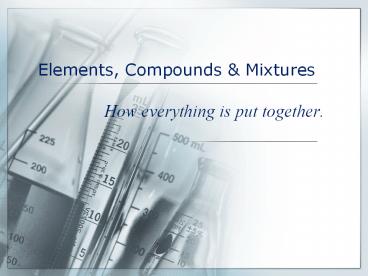Elements, Compounds - PowerPoint PPT Presentation
1 / 32
Title: Elements, Compounds
1
Elements, Compounds Mixtures
- How everything is put together.
2
Classification of Matter
3
Elements
- Matter that has the same composition and
properties throughout is called an element. - When different elements combine, other substances
are formed.
4
Elements
- Contains only one particle
- Can exist in 3 states of matter solid, liquid,
and gas
Picture from http//www.ilpi.com/msds/ref/gifs/sta
tesofmatter.gif
5
Compounds
- Ban DHMO?
- DHMO is dihydrogen monoxide.
- Evaluate the following link and decide if this
potentially dangerous chemical should be
prohibited. - www.dhmo.org
6
Compounds
- A compound is a substance whose smallest unit is
made up of atoms of more than one element bonded
together. - Compounds often have properties that are
different from the elements that make them up. - Examples Water, salt, sugar
7
Compounds
General Rules - Only write the name of the
metallic element first - Write the number
of atoms of any element in the compound in
subscript (applies to only 2 or more
atoms) - ide will always be written at the
end of the non metal element
8
Compound Properties
Compounds are formed by atoms of different
elements. However, they do not have the
properties as them. Because of chemical bonds,
compounds cannot be broken down by physical
means. They can only be broken down by chemical
reaction or electricity.
9
How do we name compounds? Rule 1
A compound made up of two elements has a name
that ends in -ide.
Sodium chloride made up of the elements
sodium and chlorine Zinc oxide made up of
the elements zinc and oxygen Carbon dioxide
made up of the elements carbon and oxygen
10
Fixed Composition of Compounds
A compound is made up of different elements
chemically combined in a fixed ratio.
For example, water (H2O) is a compound made only
by joining together two atoms of hydrogen to one
atom of oxygen. That is, the ratio of hydrogen
atoms to oxygen atoms in water is always 2 1.
11
Chemical Formula of a Compound
A compound can be represented by a chemical
formula.
The chemical formula states the types of atoms
(i.e. elements) in the compound, the ratio of
the different atoms in the compound.
Types of atoms hydrogen, oxygen Ratio of H to O
21
12
How do we write chemical formula?Rule 1
For many compounds that contain both metallic and
non-metallic elements, the symbol of the metallic
element is written first.
calcium oxide (CaO) sodium chloride (NaCl)
magnesium carbonate (MgCO3)
13
How do we write chemical formula?Rule 2
The number of atoms is written as a subscript, to
the right of the atoms symbol.
water (H2O, not H2O or 2HO) magnesium
carbonate (MgCO3, not MgCO3 or MgC3O)
14
How do we write chemical formula?Rule 3
It is not necessary to write the subscript 1.
water (H2O, not H2O1) calcium oxide (CaO,
not Ca1O1)
15
How do we write chemical formula?Rule 4
The oxygen atom is usually written at the end of
the formula.
water (H2O, not OH2) carbon dioxide (CO2,
not O2C) nitric acid (HNO3, not O3NH)
16
Lets try it
- How many atoms of each element are there in the
compound? - Sulfuric Acid H2SO4
- __ Hydrogen
- __ Sulfur
- __ Oxygen
- Hydrogen Peroxide H2O2
- __ Hydrogen
- __ Oxygen
17
And some more formulas
- Carbon Dioxide CO2
- __ Carbon
- __ Oxygen
- Carbon Monoxide CO
- __ Carbon
- __ Oxygen
- Calcium Carbonate CaCO3
- __ Calcium
- __ Carbon
- __ Oxygen
18
Compound Review
- A pure compound has the same elements and the
same amount of elements all of the time - Elements are chemically combined
- Compound properties are different from the
properties of the elements - They cannot be separated physically
- Physical properties such as boiling point or
melting point of pure substances are do not
change
19
Mixtures
- A mixture is a combination of two or more
substances where there is no chemical combination
or reaction.
20
Mixtures combine physically in no specific
proportions. They just mix.
21
Solids, liquids and gases can be combined to
create a mixture.
22
Mixture Types
- MIXTURES MAY BE HOMOGENEOUS OR HETEROGENEOUS
23
Homogeneous Mixtures
- Homogeneous Mixtures
- The prefix "homo"- indicates the same
- Have the same uniform appearance and composition
throughout
24
Solutions
- SOLUTIONS-
- are homogeneous mixtures
25
What is a solution?
- A solution is a mixture of two or more
substances. - At least two substances must be mixed in order to
have a solution
26
A solution has two parts
- The substance in the smallest amount and the one
that DISSOLVES is called the SOLUTE
- The substance in the larger amount is called the
SOLVENT - it does the dissolving - IN most common instances water is the solvent
27
Examples of solutions
- Salt water
- Clean Air
- Vinegar
28
Heterogeneous Mixtures
- The prefix "hetero"- indicates difference
- A heterogeneous mixture consists of visibly
different substances or phases - Two or more parts can be seen
29
Examples
- Pizza
- Sandwich
- Chex Mix
30
Suspensions
- A SUSPENSION is a heterogeneous mixture of large
particles - These particles are visible and will settle out
on standing - Examples of suspensions are fine sand or silt in
water or Italian salad dressing
31
Classification of Matter
32
Compounds vs Mixtures
Compounds
Mixtures
- Combine chemically forming molecules
- Not chemically combined
- Can combine in any proportion
- Combine in set proportions
- Separated physically
- Separated chemically































